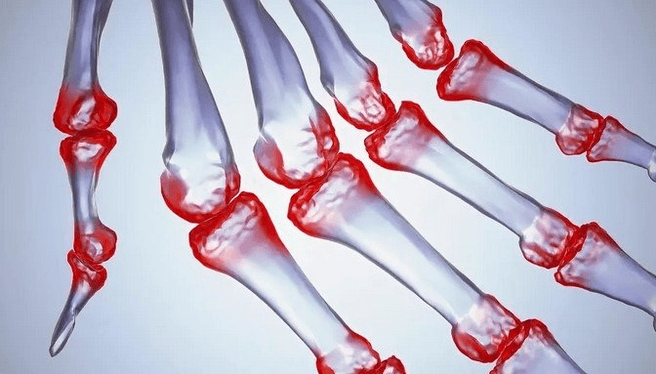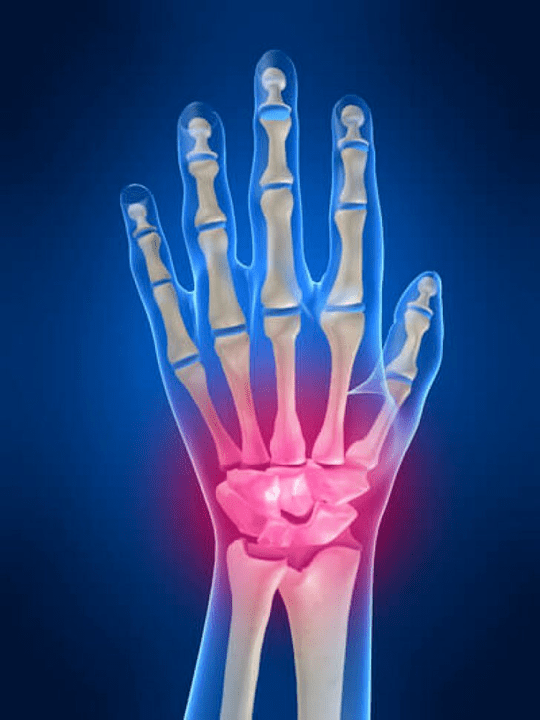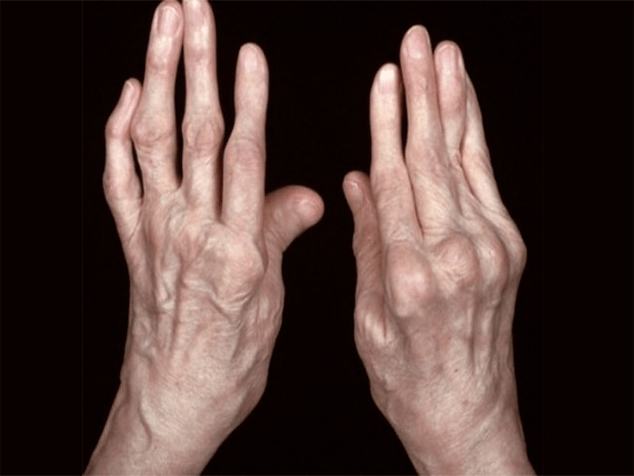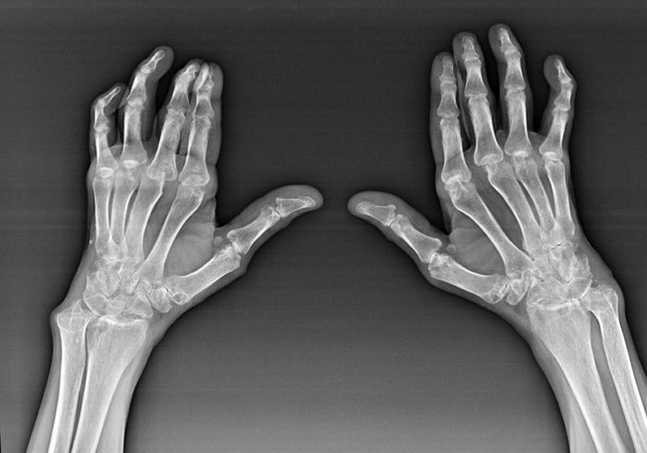
Joint painThe fingers are an essential sign of any joint pathology where the structural components of these joints are damaged.First, pain in these joint areas may be associated with various autoimmune diseases (Red luster throughout the body, rheumatoid arthritis, psoriatic arthritis, etc.) Among them, immune factors will damage their own joint tissue.
The next main reason why it can be startedpainIn the joints of the fingers, injuries may occur (Bruises, dislocations, fractures, ligaments).The soreness in these joints can also be caused by degenerative changes in their joint tissues.This can usually be observed with osteoarthritis.
Anatomy of the hand joint
All joint habits of the hand are divided into the following groups:
- wrist joints;
- wrist joints;
- wrist joints;
- Indoor joints;
- parlemonal-phalanx joint;
- Meningeal joints.
Wrist joint
The wrist joint is formed by proximal bones (superior) Many wrists (Three heads, half moon, shoulder caphoid boneRadiation and distal areas of elbow bones.The elbow bones are not directly connected to the bones of the wrist, but with the help of the distal end (reduce) joint disk.This structure separates the cavity of the wrist joint from the distal end (reduce) Ceramic tile joints.
Wrist joint
The joints of the wrist are represented by three types of joints.The first form includes joints between the upper bones (scaphoid, half moon, three heads, pea shape) or lower row (Hook-shaped, head is head, trapezoidal, bone capture).These joints are called Interchangena joints.By the second type, SO is called the middle author joints are ranked.The joint has an S-shaped shape and is formed by the bone connections of the upper and lower rows of wrists.The third type includes the joints of pea bones.Through this joint, the three skulls are connected to the pea bone.
Capacitor - benzene fiber joint
The wrist joint connects the bones of the wrist and the metacarpal bones.These joints are formed by proximal contact (reason) The metacarpal bone and distal part of the carpal bone belonging to the second row.The wrist joint includes two main joints.The first one is the wrist joint of the thumb.It is formed by the connection between the first metacarpal bone and the bone capture.
The second joint is the common carpal tunnel joint of the wrist, used in the second, third, fourth, fifth, fifth, fifth metacarpal bones and trapezoidal shapes, head bones, part, part of bone capture.The wrist joint of the thumb is separated from the general wrist joint.Compared with other carpal tunnelsThese include general wrist joints) is considered to be sedentary.The wrist joints are enhanced by strong joint capsules and ligaments (Back and palm ligaments).
Explanatory joints
When in contact with each other, the sides of the second, third, fourth and fifth bones form a transcore joint.These joints have individual joint capsules that are close to the joint capsule.In addition to capsules, these joints also have ligament instruments, consisting of intermetachomyocyte ligaments as well as posterior and palm-type ligaments.The inserter joint is attributed to the sedentary joints of the hand because the joint surfaces of the bones forming these joints have a flat shape.
Parleen-phalanx joint
parleus-phalanx joint is a compound between the distal ends (reduce) The end with metacarpal bone and proximal end (superior) The first pointing area of finger.Each finger on the upper limb has its own metacarpophalangeal joint.Therefore, each hand has five metacarpal horizontal joints.
Meningeal joints
The vegetative chamber joints are formed by a combination of adjacent oval shapes of each finger.Big (The first) The finger has only one interactive joint, because the finger has only two oval shapes (Proximal and distal).The rest of each finger has two interactive joints.
The first one is between the first one (Near end) and the second (Average) fingers and phalanx called proximal ends (superior) Interphalang joint.The second form the connection between the average (second) and last (remote) Finger edge.The second interphalangeal joint is called the distal interactive joint.Strengthen the joint between the lumen and palm ligaments.These joints are block joints and can only move around the forehead (Fight and bend).

In the hand joint, which structures become inflamed?
Inflammation is a typical pathological process characteristic of tissues and organs damaged by any cause.It is worth remembering that in most cases,For example, gout, rheumatoid arthritis, etc.) or trauma, damage to the hand joints of one degree or another, will not only affect the joints, but also the plant athletes (Nerves, muscles, tendons, subcutaneous fat, skin)structure.
The following joint structures can become inflamed in the joints of the hand:
- articular cartilage;
- Squeeze bone tissue;
- joint capsule;
- Joint ligaments.
Causes of hand and finger joint pain
The causes of mechanical damage are one of the main causes of pain in the hands and finger joints (Breakage, dislocation, bruising, etc.) and systemic autoimmune diseases (Rheumatoid arthritis, systemic lupus erythematosus, psoriasis, etc.).In addition to these reasons, soreness in the hand joints can also cause diseases related to metabolic diseases (For example, gout, osteoarthritis).

There are the following main causes of pain in the hands and finger joints:
- bruises on hands and fingers;
- Brush bone fracture;
- Dislocation of the brush;
- ligamental lesions in the hand;
- rheumatoid arthritis;
- Kimbaker's disease;
- Reactive arthritis;
- gout;
- psoriatic arthritis;
- Synovitis;
- osteoarthritis;
- Systemic lupus red.
Bruises on brushes and fingers
Bruises are one of the types of closed injuries where soft tissue is damaged (Muscles, tendons, nerves, skin), there are no wounds in the places indicating the main effect of the trauma factor.Fingers and soft tissue bruises on fingers are rarely found in isolation (Separately) From bruises from the joints of the hands and fingers.Therefore, under this type of injury, mixed symptoms were found, indicating damage to the opponent's joints, as well as surrounding lesions (- Human) fabric.Bruises on brushes and fingers are usually found when they fall on the hand and are damaged by blunt objects to compress or clamp.
Often, bruising in the cystic zone can cause damage to the main trunk of the median, radial, elbow nerves (Which dominates the area of the hand and fingers), which immediately manifests itself as a loss of skin sensitivity, and in some cases, even the disappearance of motor function of the finger.
Inflammatory edema in joints and human cycle structures forms due to the expansion of numerous blood vessels, which are the blood supply.This edema is one of the reactions to inflammation, which occurs due to damage to tissue during bruising.
Brush skeleton fracture
Often, the cause of hand pain can be caused by various fractures of its bones, as these bones are registered directly in joint surface formation.All fractures were divided into three main groups according to the anatomical location of the damaged bone.The first group consists of wrist fractures.The second includes the cracks in the skeleton of the tubular priest bone.The third group includes skeletal fractures of the finger bone.
The most common damage sites in the brush wristband are the half moon and shoulder cap bone.These fractures of the bones occur on the brush and are accompanied by pain in the wrist and mid-wrist joint areas.Pain syndrome can also be observed in the anatomical location of these bones.
The most common fracture at the end of the metacarpal bone is the base crack of the first metacarpal bone (The one attached to the bone of the thumb).Due to this injury, edema and soreness appear in the area at the base of the first meta bone, as well as the part of the carpal joint directly adjacent to it.Shorten, bend and causes the thumb of the palm to be shortened, bend and causes your palm.His movements are limited.
The cracks of the brush are accompanied by deformation, a decrease in finger length, loss of function, and during the period - intraluminal joints and pharyngeal shape - severe pain and swelling in human tissues.Palpated fracture of a finger bone fracture (bone fragment) (palpation) You can identify their bulges on the palm surface of the brush, and instead, the back is a hole or isolation.These fragments are usually movable, and near them you can usually detect subcutaneous bleeding (hematoma).
brush
Dislocation is a pathological condition in which the region of the bone forming any joint exceeds its anatomical limit, thus manifesting as a result of a complete or partial loss of the joint function.In addition to impaired joint function during dislocation, affected joints were also found, swelling and localized increase in temperature.During the dislocation of the brush, the emergence of swelling is explained not only by the inflammation in damaged -human tissues and the presence of the structure of the joint, but also by the emanating protrusion of the bone joint.
The most common type of dislocation of brushes
| Misplaced names | Dislocation mechanism | Which joint was surprised? |
| The real dislocation of the brush | The joint surface of the wrist bone is facing towards the posterior part of the palm or hand relative to the joint surface of the radial bone. |
|
| Perrunar dislocation | The bones of the wrist and the rest of the brush move relative to the noon and radial bones on the back of the brush. |
|
| Dislocation of bones | Meanwhile, caphoid bones show dislocation on the radiation side in parallel (On the same plane) to the nearby wrist bone.Sometimes it may transfer on the palm side, i.e. switch to the palm of the bone-captured hand, less on the same side of the trapezoidal bone. |
|
| Dislocation of the half moon | There is a half month slip in the direction of the palm, so the space for the bone is still not busy.It is gradually occupied by the skull, penetrating from the second row of the bones on the wrist.This dislocation is a complication of self-regulation of peri-bone dislocation. |
|
| The first metacarpal bone dislocation | The joint surface at the base of the first metacarpal bone moves relative to the joint surface captured by the bone on the radial side (upward)Near end), on the same plane, with bones of wrists.So pull your thumb back a little, towards your wrist joint. |
|
| Dislocation of fingers | There is finger dislocation in the joints of the palm and interfrequency joints.First, the joint surface of the proximal needle of the finger (With the whole finger) Move relative to the joint surface of the metacarpal bone.Second, there is a displacement between the bones of the finger itself.Usually, the finger bones have back and palm dislocations. |
|
Damage to the opponent's ligament
The lesions of ligaments as well as the bruises of the brush are attributed to the closed traumatic injury.This pathology is mainly due to excessive stretching of the hand, with the fingers stretching in any direction.The main lesions of a bunch of brushes are their stretching and rupture.As the damage area stretched, slight revoltage and partial rupture of the connective tissue fibers were observed.As the ligament ruptures, the entire ligament is divided into two endless ends.
The following main types of brush ligaments are distinguished:
- rupture of the radial collateral ligament of the wrist;
- ruptured collateral ligament on the wrist;
- Crack breaks;
- rupture of the lateral ligament of the metacarpal balance joint;
- rupture of the interlateral ligament.
Rheumatoid arthritis
Rheumatoid arthritis is a disease in which the human immune system damages the body's own tissues.In other words, rheumatoid arthritis is an autoimmune pathology.The disease is also systemic because many tissues are affected (Muscles, joints, containers, etc.) and organs (Heart, kidney, lungs, etc.) in the body.
Although rheumatoid arthritis is a systemic disease under it, to a large extent, joints are affected, while lesions in other tissues and organs are in the background.With this disease, almost all types of brush joints can be affected (wrist, carpal tunnel, palm pal-phalanx, interbrain joints).The lesions are usually symmetrical (Those ones.The same joints are affected) hands, accompanied by swelling and joint damage pain.In the morning, during the prosecution in bed, the affected joints have some stiffness that can last about 1 hour and then disappear without traces.
Rheumatoid arthritis often occurs near the affected brush (Piano - Interventricular joints are more frequent) Rheumatoid nodules.They are round strata located below the skin.On brushes, these strata are most commonly found on the back.At palpation, they are dense, inactive, and painless.Their numbers may vary.
Kimbaker's disease
Kimbeck's disease is a pathology in which the half-moon wrist bone of the brush is affected.The disease develops due to long-term physical overload of the palm.Usually, it happens to experts in architecture professionals - glass, mason, joinery, etc.Excessive physical exercise in the palm of the palm is usually this bone because it occupies the center of the wrist joint.Most commonly, during Kimbeck's disease, the brushes of one hand are affected and are usually predominant.The right hand is damaged, the left hand is damaged).
Reactive arthritis
Reactive arthritis is a pathology of the origin of immune pathology, and its own immune system attacks various joints in the body, which is why it occurs in autoimmune inflammation.Unlike other autoimmune diseases (For example, rheumatoid arthritis, systemic lupus erythematosus, the occurrence of presumed infectious origin) In reactive arthritis, there is a clear relationship between infections (And especially intestinal or genital) and the development of joint lesions.
Likewise, with this pathology, lymph nodes can increase and fever appear.Over time, when reactive arthritis transitions to a chronic form, it may indicate signs of kidney disease, heart and muscle atrophy, and cystitis may occur (Inflammation of periosteal bag),tendon(Inflammation of tendon vagina)wait.
gout
Gout is a disease based on the development of uric acid accumulation in the body and its deposition of salt in joints.Uric acid is the final product of purine and pyrimidine base metabolism.They are the basis for building DNA and RNA molecules, and certain energy forms (Adenosine adenosine triphosphate, adenosine monophosphate, etc.) and vitamins.
The pain of gout mainly occurs in the small joints of the lower limbs and upper limbs.Furthermore, in 50% of clinical cases, the disease begins with the first plus joint in the leg.Usually, the interactive joints of the fingers are affected, reducing the radiation joints.Gout usually damages one or more joints on one limb, and sometimes the joints of the other limbs are involved in the inflammatory process.
Psoriatic arthritis
Psoriatic arthritis is a pathology in which various joints become inflamed in the context of psoriasis.The development of psoriasis is based on the result of violating the interaction between immune cells and skin cells (in the bodyEspecially in the skin) There is an autoimmune reaction that causes inflammation.
Synovitis
Synovitis is an inflammation of the synovium of the joint, accompanied by damage to its tissues and the accumulation of pathological fluids in the affected joints.Synovitis is not a separate disease, but a complication of other diseases.Endocrine, allergic, infectious, autoimmune pathology, brushes, etc. may occur.
Osteoarthritis
Osteoarthritis is a disease that violates the process of normal cartilage tissue formation in various joints.These processes are violated under certain external and internal tendency factors.They can be persistent joint injury, long-term physical exercise (In work, daily life, exercise), genetics, other joint diseases, etc.
The joints of the fingers are sore due to this pathology because they are around (- Human) The tissues develop inflammation and the nerves are affected.One characteristic of osteoarthritis is the connection between pain and physical activity.The soreness in the joints occurs primarily and/or after and disappears after heavy physical overload or after rest.
Systemic red lupus
Systemic lupus erythematosus is an autoimmune pathology in which in the human body, there is the production of an autoimmune antibody that attacks various cell and tissue structures.In particular, production of SO antinuclear antibodies that damage cell nuclei and DNA and RNA molecules was observed.With red lupus, various fabrics and organs are affected - leather, containers, heart, pleura, pericardial, kidney, joints, etc.
Systemic red lupus is constantly associated with other additional - independent symbols - weakness, weight loss, fever (Improve body temperature).However, the most important thing about special symptoms is that there is no diagnosis of the symptoms.These special signs are photoabdominitis (Skin inflammation under the influence of sunlight), disc-shaped rash (Appearance on the skin around the neck), Lupe Butterfly (The appearance of red spots on the skin near the nose), oral erosion, kidney damage (Glomerular nephritis), serum material (Serous inflammation)wait.
Diagnosing the cause of pain

The pain in the hands is involved in the diagnosis and treatment of the causes of pain, mainly trauma scientists and type A doctors.To diagnose these reasons, these doctors mainly use clinical (Dissolution collection, external examination, palpation, etc.), radial(Radiography, computed tomography) and laboratory (General blood tests, biochemical blood tests, etc.) Research methods.
According to the cause of joint pain in the hand, all diagnosis can be divided into the following sections:
- Diagnosing traumatic damage to brushes (Bruises, dislocations, fractures, ligaments);
- Diagnosis of rheumatoid arthritis;
- Diagnosed Kimbeck's disease;
- Diagnosis of reactive arthritis;
- Gout diagnosis;
- Diagnosis of psoriatic arthritis;
- Diagnosis of synovitis;
- Diagnosing osteoarthritis;
- Diagnosis of systemic lupus erythematosus.
Diagnosing traumatic brush injury
You should consult a trauma scientist when the brush is injured.The main diagnostic methods used in medical practice to determine traumatic damage to the brush (Fracture, dislocation, ligament, bruises), is an external examination, anatomy, and research radiation method (Radiography, computed tomography).
The collection of agent-free data allows doctors to identify events that cause or may cause brush injuries.A history of hemodynamics is also used to clarify the symptoms that plague patients.During external examination of the brush, swelling, hematoma, its deformation, limitations of joint mobility can be detected.With the help of palpation, doctors revealed the presence of pain, violation of the anatomical shape of the joint, and damage to the ligament.Researched radiation method (Radiography, computed tomography) They allow you to confirm the diagnosis, as mechanical damage to the brush anatomy is clearly seen during use.
Treatment of pathology causing hand arthritis

To treat the pain in the hands and finger joints, the doctor first prescribed a variety of medications (Anti-inflammatory drugs, painkillers, anti-rhevetas drugs, etc.).In some cases, they combine the use of these products with a physical therapy procedure.Traumatic injury to the brush is most often treated surgically or applied to the affected upper limbs of the gypsum bandage.
To relieve pain and relieve inflammation, the first thing is to use external NSAID.The drug selectively blocks COO-2 and acts directly on the source of pain.Due to the special texture, the clothes without traces have a pleasant smell, which will absorb it soon.
According to the pathology that causes inflammation of the hand joint, all treatments can be divided into the following parts:
- Treatment of traumatic damage to brushes (Bruises, dislocations, fractures, ligaments);
- Treatment of rheumatoid arthritis;
- Treatment of Kimbaker's disease;
- Treatment of reactive arthritis;
- Gout treatment;
- Treatment of psoriasis arthritis;
- Synovitis treatment;
- Treat osteoarthritis;
- Treatment of systemic lupus erythematosus.






















